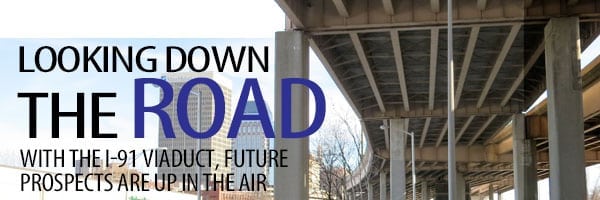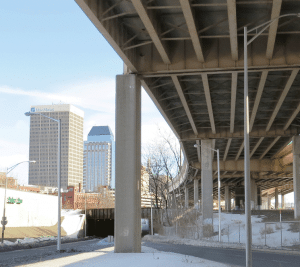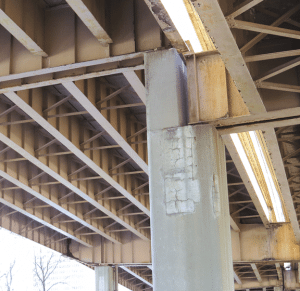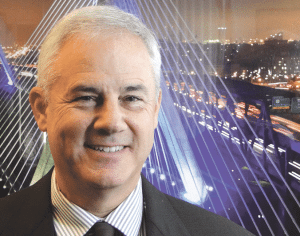
Looking Down the Road
With the I-91 Viaduct, Future Prospects Are Up in the Air
 Nick Fyntrilakis, vice president of Community Responsibility for MassMutual and frequent spokesperson for the financial-services giant, urged the state to hit the ‘pause’ button when it comes to a planned $260 million project to replace the stretch of Interstate 91 that runs through the center of Springfield and is known as the ‘viaduct.’
Nick Fyntrilakis, vice president of Community Responsibility for MassMutual and frequent spokesperson for the financial-services giant, urged the state to hit the ‘pause’ button when it comes to a planned $260 million project to replace the stretch of Interstate 91 that runs through the center of Springfield and is known as the ‘viaduct.’
He used that term at a well-attended public hearing on the massive public-works project late last month, and in reference to another, much broader possible plan for the stretch of I-91 that slices through the very heart of the city’s central business district — taking it down to street level or perhaps even below street level, thus facilitating the process of reconnecting the city with the Connecticut River for the first time since construction of the highway began a half-century ago.
“We see this as a possible game changer, a once-in-a-lifetime opportunity to fix a 60-year-old problem in the city of Springfield — being disconnected from the riverfront and the access to economic-development opportunities that exist there,” he told those assembled, and especially Michael O’Dowd, project manager for the Mass. Department of Transportation (DOT). “If this [repair] project proceeds as proposed, it’s going to be very difficult to see $260 million of work just go away based on another design that comes up through the planning effort.
“If we go down this road,” he went on, again referring to the repair project, “we’re going to miss an opportunity, and we’re going to have this viaduct for the next 40 or 50 years, which I don’t think the majority of the community is looking for.”
And therein lies the problem, or controversy, arising at a time when most would expect public officials and business leaders to be thrilled, or at least happy, with the prospect of the federal and state governments spending a quarter of a billion dollars to fix a very tired stretch of road.

Officials with MassDOT say the proposed repairs of the viaduct section of I-91 cannot wait due to the deteriorating condition of the roadway and cost of continually patching it.
But the pause that Fyntrilakis and others are seeking — to study a potentially bolder endeavor involving the viaduct — is not likely, or even advisable, said O’Dowd.
That’s because this section of I-91 is deteriorating rapidly, and the state is spending about $2 million a year annually on what amount to patch jobs that do little but buy the city some time. And, in his opinion, it can’t buy any more.
“This is something that needs to be done now,” he said at the public hearing, putting the accent on that last word as he talked about the financial and safety considerations that he believes should deter any delays in getting started.
But beyond those aspects of hitting ‘pause’ on the viaduct work, there are also economic-development concerns, said Jeffrey Ciuffreda, president of the Affiliated Chambers of Commerce of Greater Springfield.
He told BusinessWest that discussions about an extensive ‘repair-in-place’ project involving the viaduct have been ongoing for some time. But they took a far more serious tone — and the initiative moved into a faster lane, if you will — after the second level of the I-91 South parking garage had to be closed for an extended period due to falling concrete from the deck above.
“That convinced people that this was serious — it really showed the economic impact upon Springfield,” he said, adding that there are several buildings downtown that don’t have attached parking and rely on the I-91 lots. “When they closed that floor of the parking garage and told everyone to park in I-91 North, that overloaded that system, and we started realizing how dependent downtown Springfield is on two or three parking facilities.”

Frank DePaola says accelerated bridge construction, or ABC, should allow crews to complete the repairs of the viaduct section of I-91 in three construction seasons.
For this issue and its focus on environment and engineering, BusinessWest focuses on those steps and many other aspects of what is turning into a controversial project long before any work actually begins.
Concrete Examples
It’s called ‘accelerated bridge construction,’ another term simplified to the acronym ABC.
And, as the name implies, it involves processes and materials — such as pre-fabricated sections of highway decking — that enables projects such as the proposed I-91 initiative to be completed in less time than under more traditional methods, said Frank DePaola, MassDOT highway administrator.
Before elaborating on just what’s involved, he told BusinessWest that the state has already had some experience with ABC, and it’s due to get quite a bit more in the years to come, because there are many elevated sections of highway like Springfield’s I-91 viaduct, most of which were built about the same time — the mid- to late ’60s, as the Interstate Highway Project was reaching its zenith — and they’re in generally the same condition: poor.
A partial list would include the I-90 (Mass. Turnpike) viaduct in Boston, the Route 79 viaduct in Fall River, the McCarthy Overpass in Sommerville, and a section of I-93 North that also passes through Sommerville, he said, adding that some have been repaired and others are awaiting work.
Reiterating O’Dowd’s comments, he said the work in Springfield cannot, and should not, be put off much longer.
“Over the years, the water, the salt, and just the weather elements have weathered the deck, so that without predictability, sections of the deck fall out, and we have to go out there and patch holes in the deck,” he explained. “We’ve spent, on average, $2 million a year patching the holes in the deck.”
Beyond this cost, and the safety element driven home by the closing of the upper level of the parking garage, there is a “nuisance factor” as well, he said, noting these patch jobs he described entail shutting down lanes of the highway for sometimes long stretches at a time.
Rather than continue with this frustrating, Sisyphean approach, the state has proposed an ambitious, and expensive, plan to replace the decking on the 67 spans of northbound highway within the viaduct and the 62 spans on the southbound section.
If all goes as planned, the contract for the repair project will be awarded later this year, and work is expected to commence late this fall. The plan is to keep two of the three lanes in both the north- and southbound sections open at all times, said DePaola, noting that, while 14 sections of I-93 were replaced in 10 weeks by shutting that section of the highway down completely, a similar strategy is neither necessary nor recommended for Springfield’s viaduct.
Keeping two lanes of traffic open on both the north- and southbound sections of the highway will reduce the overall inconvenience from the project, but there will undoubtedly be an impact on commuters as off-ramps are closed and traffic is detoured onto East Columbus and West Columbus avenues and other arteries, said O’Dowd at the public hearing.
Exits 6 and 7 on I-91 South will be closed, and traffic detoured to a temporary ramp to be constructed north of exit 8 to provide access to downtown Springfield via West and East Columbus avenues. The on-ramps to I-91 North from both State and Union streets will also have to be closed, he went on. I-91 northbound access will be provided via East Columbus Avenue, with I-291 access provided via a detour off East Columbus Avenue to Liberty and Dwight streets.
Ramping Up
Ciuffreda, who has many not-so-fond recollections of the I-91 ramp-reversal project that accompanied the opening of the new Basketball Hall of Fame, said residents, business owners, and those who work downtown couldn’t be blamed for being skeptical about vows to minimize the disruption from the planned I-91 project.
Indeed, the ramp project took far longer than originally estimated, and the impact was considerable. And those same things can be said about the Memorial Bridge reconstruction that took place 20 years ago, and the more recent repairs to the South End Bridge.
But Ciuffreda believes there is also room for optimism with regard to the I-91 initiative.
“The state has come a long way with how they go about construction projects like this one,” he said, citing the I-93 repairs as one example. “It’s going to be a major, major construction project, but they feel pretty comfortable — and I feel pretty comfortable — that they can minimize the downside of it.
“Clearly there will be disruptions — you can’t do a major construction project without them — but I think they’ve learned enough to expedite it and to minimize the adverse effects.”
But the 17-day run of the Big E each fall will severely test the patience, and the abilities, of those trying to keep the traffic flowing, he added quickly, noting that construction might have to be shut down during the fair’s run, and other steps, such as shuttling visitors from remote locations, might have to be undertaken.
And if a license is granted for MGM’s proposed South End resort casino, as expected, and construction begins later this year — that’s the current timetable — two of the biggest construction projects in the region’s history would be going on at the same time, and within a few hundred feet of each other.
Overall, effective communication with the public about the project, specific phases, lane and off-ramp closings, and other considerations are vital to efforts to minimize disruptions and the impact on commerce, said Kevin Kennedy, Springfield’s chief development officer.
“My issue is to make sure there’s enough communication so that we know where they’re working so we can tell people who work and come to downtown Springfield and use our parking facilities what’s going on and what the best route to get here is going to be,” he said. “It’s going to uncomfortable for a while, and no one likes that, but the idea that we can get a good fix, rather than a patch job, is good for Springfield in the long run.”
As for that broader vision for the viaduct and improved access to the river that Fyntrilakis mentioned, there is a study, being conducted independent of the repair project, that is exploring options.
Springfield Mayor Domenic Sarno has repeatedly called for something “bold and visionary” in his public comments on the matter, and State Transportation Secretary Richard Davey said it might be possible to take some sections of the elevated highway down to grade level or just below.
But there are myriad questions that will be need to be answered, about everything from what the soils can handle to how other barriers to the riverfront, such as East and West Columbus avenues and the rail line just east of the river would be negotiated; from how such a project would be funded to whether the state and federal governments would invest heavily again in a road they just paid $260 million to fix.
“Once the repair project starts, it will take some of the options off the table for getting to the riverfront, but I’m not sure it takes all of them off the table,” said Ciuffreda. “We may have to settle for a lesser connection than we ideally would like. That’s just the hand we’ve been dealt. It’s a crumbling road, and if it ever went down to one lane, that would just cripple the economy.”
Bottom Line
How that hand will be played remains to be seen, but it appears that the pause sought by Fyntrilakis and others is not in the cards.
And for that reason, projecting down the road, for the short and long term, will be difficult. That’s why, when it comes to Springfield and its controversial, half-century-old viaduct, so many things are still up in the air.
George O’Brien can be reached at [email protected]




